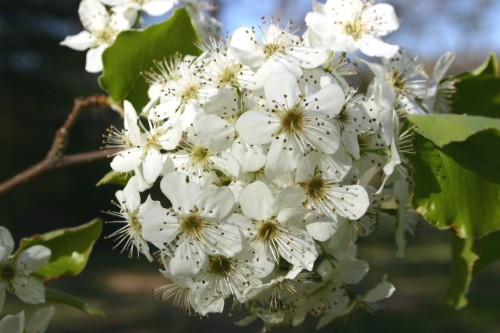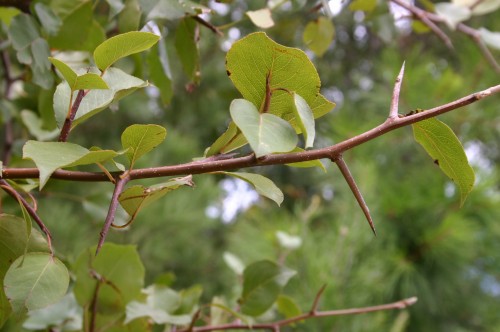





Curtis Young , editor, and other contributors to the Buckeye Yard and Garden Line have shed light on why there are so many thorny sprouts of wild pear showing up unwanted every year.
“One of the certainties of education is that as you age you become aware that there is more and more to learn and that you are absolutely certain about less and less. No one will ever master gardening. This is good to remember relative to the story of Callery pear (Pyrus calleryana).
“Callery pears were brought into the US to cross with fruiting pears, with the idea that they would provide some genes for resistance for bacterial fireblight disease. The crosses did not fare so well, but as USDA researchers looked out at plantings, lo and behold Pyrus calleryana ‘Bradford’ did seem to look like the perfect street tree. Snowy white flowers, glossy green leaves, great burnished-red fall color, and because of genetic self-incompatibility, hardly ever were there any fruits (meaning no mess).
“Thus, Pyrus calleryana ‘Bradford’ was widely planted as a street tree. It had great ornamental attributes. Some felt it was “overplanted,” but the reason was that so many liked it. Soon, though, it was noted by arborists that the crotch angles of the branches were an Achilles heel; the angles were weak which resulted in a lot of storm damage. Soon, street tree commissions demanded “no more pears.” Often these groups were not very discriminating, banning “flowering pears,” “ornamental pears,” and “Bradford pears.”
“Many horticulturists come to defend Callery pears, pointing out that other cultivars (cultivated varieties) of Pyrus calleryana had better branch structure, including cultivars such as ‘Aristocrat’ and ‘Cleveland Select’. We said, don’t throw the baby out with the bathwater, and make sure which Callery pears you are belittling. Names matter. Meanwhile, for years many of us noted that one of the outstanding features of Callery pears was changing; more and more fruits were showing up on the trees. In the early days, you almost never saw any of the small tan globes; over time we noticed more and more of these fruits appearing on trees, resulting in a messy tree.
“Teresa Culley of the University of Cincinnati and others brought to light what was happening. Though ‘Bradford’ Callery pear was still largely self-incompatible, the other cultivars, originating from slightly different plants (e.g. better branch structure) and then cloned, were crossing. They were then spread by Angry Birds and showing up by the thousands upon thousands where they were not planted by humans. Many natural area managers now are concerned that Callery pears are an invasive plant threat. The ultimate fate of this plant in native areas in still an unfolding story, but it proves the point that all such stories of nature and nurture are ultimately never-ending. Don’t look now, but what you knew yesterday was not the last word.
As Kim Todd pointed out in the book “Tinkering with Eden,”
“So we should do what we can, take actions that make the most sense to us given our present understanding, proceed with caution, work to expand our peripheral vision so it takes in more species and unglimpsed possibilities, reach to see beyond the effects we hope to achieve. We should also rest assured that in the half-light at the end of the working day, no matter how we open our eyes and how finely we tune our fortune-telling instruments, no matter how many times we re-check the calculations and stretch to account for the earth complete and entire, the natural world will continue to rattle, buck, elude, and astonish us, serving up results far beyond the imagination.”


Copyright © www.100flowers.win Botanic Garden All Rights Reserved